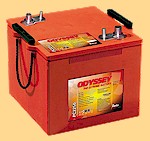Batteries for inland craft
For inland craft, such as narrow boats, the most cost effective option is to use the 2V wet lead/acid traction cells as seen in fork lift trucks and milk floats. These cells provide long life if you look after them. They come with a 5 year guarantee and have an expected service life of 10 years.
The cells can be heavy but you just reduce ballast to compensate, the result is weight neutral.
The cells do need topping up and will gas when being charged. We have solved these issues with a combined automatic watering and venting system that is very simple to install. This is provided as standard with all our canal boat packages.
See the down loads page for examples of our hybrid canal boat installations and the creative ways owners have used to fit their battery banks.

Batteries for sea going craft
For most seagoing vessels it is appropriate to use sealed (valve regulated) batteries of the Gell or AGM type. These need to be fitted in their own box with a vent to the outside world.
We are working with Odyssey "Thin Plate Pure Lead" Technology (TPPL) lead acid batteries. For a detailed discussion of this technology go to http://proboat.com and view on line the Feb/Mar 08 issue of Professional Boat Builder (Page 104) . You may need to register but it is free !




Download brochure on Odyssey PC2250 batteries
If you are retro-fitting a hybrid system to an existing craft then you will need to consider how may batteries you can carry and where to put them. Our hybrids use a 48V battery bank so as a minimum you would need four 12V batteries in series.
If you are building your boat from new then you will probably have more flexibility. Needless to say wherever the batteries are placed they need to be kept absolutely dry. Sea water and batteries do not mix! As an example I show below how our experimental craft was built around carrying a large amount of batteries.
The obvious place to stow the batteries is low down in the keel. If this is accounted for during the build then ballast can be reduced to compensate for the cells, thus no extra weight is added. The prototype system is fitted into a long keel steel yacht.
Alice and Rosie inspecting the battery compartment
As can be seen there is plenty of depth in the keel with the width restricted to just over one foot (330mm). In this case we fitted 2V cells, these are six inches wide (158mm) and can be obtained in a number of depths and widths according to their capacity.

Here are the batteries at our workshop. They are in a box that is roughly the size of the keel. 24 cells have been used connected in series. This gives 48V at 390 A/h . It is not recommended to discharge the cells below 20% capacity so this provides ----> 48V * (390*0.8) = 15kWh of usable energy. For the 10M / 8 tonne vessel the batteries provide 6-8 hours running at 5kts in calm conditions.
The batteries selected are wet lead/acid and are the most electricaly (though not mechanically) robust of the available types for developing our charging methods with. However they require a very involved installation. When using wet lead/acid batteries careful attention must be paid to safety. Charging cells give off Hydrogen and Oxygen and this is an explosive mixture. The cells must be kept in a sealed compartment and vented to the outside world. In this case forced air venting is employed where both ends of the compartment are connected to the outside world via flexible tubing. A small fan is connected in line and draws air in through one tube, across the batteries and out through the second tube. The fan is activated during charging and for an hour after charging stops.
For marine systems sealed batteries offer significant advantages in simpler installation, reduced maintenance and minimal gassing (only a simple vent required).